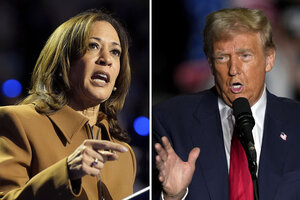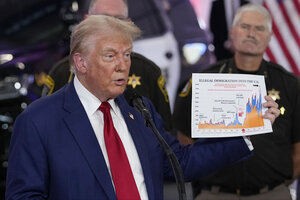How would Kamala Harris govern? Her past career offers signals.
Kamala Harris has spent nearly her entire career working in government. Viewed by many as a rising star from the outset, she moved doggedly from the District Attorney’s Office in San Francisco to state attorney general. She won a U.S. Senate seat on her first try, and just four years later was tapped as President Joe Biden’s second in command.
Asked to characterize her record over the course of her 20 years in public office, longtime political observer John Pitney sums it up this way: “progressive, but not radical.” In many ways, he says, a Harris presidency would probably look a lot like an extension of the Biden presidency. “If you like what Joe Biden tried to do, you’ll like what Kamala Harris tries to do,” says Dr. Pitney, a professor of politics at Claremont McKenna College in California.
Harris and the California years: “smart on crime”?
When Ms. Harris ran for district attorney in 2003, the San Francisco Chronicle ran this headline in its endorsement: “Harris, for Law and Order.” She campaigned to the right of the incumbent (her former boss), promising higher conviction rates, higher prosecution of drug crimes, and better relations with police. She later touted a felony conviction rate far higher than her predecessor’s.
The goal of reducing recidivism
She also wanted to reduce the number of repeat offenders. As district attorney, she started a diversion program for first-time, nonviolent offenders in low-level drug sales. Fewer than 10% of graduates from the Back on Track program reoffended. Citing statistics that most incarcerated people were high school dropouts, she created a truancy court that held parents accountable for school attendance. Between 2005 and 2009, habitual absences at elementary schools dropped by half.
“She was both tough on crime and tried to prevent crime, and that’s where you really want to be,” says former California Sen. Barbara Boxer.
Opposition to death penalty
Ms. Harris outlined her approach in a book, “Smart on Crime.” But her staunch opposition to the death penalty drew sharp criticism when a man shot and killed a San Francisco police officer. At the officer’s funeral in 2004, California Sen. Dianne Feinstein drew a standing ovation when she said the case warranted the death penalty. Ms. Harris sat in a front pew. She did not change her mind.
After a squeaker election in 2010, Ms. Harris became attorney general. She is often described as “careful” in that job, eyeing higher political office. Unlike previous attorneys general, she refused to take positions on ballot measures.
Addressing a foreclosure wave and consumer issues
She talks today about going after for-profit colleges and big banks when she was California attorney general. The mortgage foreclosure crisis defined her six-year tenure.
“She did not burnish herself as a ‘top cop’ but more as an attorney general on consumer issues,” says Rob Stutzman, a California Republican strategist who does not support Donald Trump.
The Great Recession was still reverberating in California when Ms. Harris became attorney general in 2011. Nearly a third of homeowners were underwater, owing more on their homes than they were worth. More than 10% were seriously delinquent on mortgages.
In a high-risk move, she broke with negotiations that the Obama administration was carrying out with the nation’s five largest banks over predatory lending practices. The hardball tactics paid off. She substantially increased California’s take, winning a $20 billion settlement to help Golden State homeowners. She also pushed a homeowners’ “bill of rights” through the state Legislature.
She also took on the tech industry in a sprawling case against a now-defunct sex advertising internet site, Backpage.com, the leading online venue for prostitution ads – some of which trafficked minors. The site operated in 50 states, but Ms. Harris was the first state attorney general to bring a criminal case.
Senator Harris: the anti-Trump
Ms. Harris was elected to the U.S. Senate in 2016, the same year voters sent Mr. Trump to the White House. Like Barack Obama, she ran for president before finishing her first term.
The nonpartisan GovTrack ranked her as the fourth-most-left senator during her time in office, based on bills sponsored and co-sponsored. But with Democrats in the minority, she didn’t have much legislative impact.
Ms. Harris churned out more than 130 bills and resolutions; only four became law. Her bills reflected her interests: legal representation for detained unauthorized immigrants, inclusion of gender identity and sexual orientation in the census, a tax credit for overburdened renters, aid for working parents by helping elementary schools stay open longer. A version of her bill defining lynching as a federal hate crime was eventually signed into law, in a slightly different form.
An interest in moms and health care
As vice president, she later brought some of these ideas to the White House. A monthly child tax credit became part of the American Rescue Plan, and the Build Back Better Act included provisions to improve maternal and infant health – particularly for people of color.
No vice president had ever emphasized this maternal health issue, says Dan Morain, a longtime California journalist and author of the book “Kamala’s Way: An American Life.” “It’s not a big war-and-peace-type issue, but it is of vital importance to moms and their babies.”
At hearings, a prosecutor’s zeal on display
Much of the attention Ms. Harris attracted during her time in the Senate came from her white-hot grilling of administration nominees and officials at hearings.
In 2017, she relentlessly pressed then-Attorney General Jeff Sessions when he appeared before the Senate Intelligence Committee. Under her rapid-fire questioning about whether he had met with Russian intelligence at the Republican National Convention in Cleveland, Mr. Sessions stammered, “I’m not able to be rushed this fast. It makes me nervous.”
At Brett Kavanaugh’s explosive Supreme Court nomination hearing in 2018, she seemed to catch him off guard when she asked, “Can you think of any laws that give the government the power to make decisions about the male body?” His answer: “I’m not – I’m not – I’m not thinking of any right now, senator.”
“I remember thinking at the time that it was almost painstakingly scripted to be a precampaign type of moment for her,” says Mr. Stutzman, the GOP consultant.
Role as vice president
As vice president, Ms. Harris got off to a rough start. She took office during the height of the COVID-19 pandemic, which limited her events and travel. Uncertainty about her boss’s future plans – will he or won’t he run for reelection? – created ambiguity about her own trajectory. And President Biden, unlike Mr. Trump, Mr. Obama, and George W. Bush, didn’t need his vice president to take the lead on Capitol Hill or diplomatic affairs. He had a Washington résumé a mile long.
“Harder than being a vice president is being the vice president to a former vice president,” writes Franklin Foer in his book “The Last Politician,” about the Biden presidency.
Problems soon arose within her office: high staff turnover, complaints about her being a tough boss, an indeterminate portfolio – troubles that had dogged her earlier campaign for the presidency. She also had awkward interactions with the media, including a 2021 interview with NBC’s Lester Holt on immigration.
Eventually, things improved. She grew more comfortable in her role as loyal administration messenger, adjunct diplomat, and behind-the-scenes adviser. She became an effective megaphone on women’s reproductive rights. She delivered important security messages to European leaders. She quietly nudged the president toward choosing Ketanji Brown Jackson as his Supreme Court nominee.
From the beginning, President Biden made clear he wanted her in on meetings and decisions. That’s invaluable on-the-job training for a promotion, should she get it.
But as a vice president-turned-candidate, “You carry the administration’s baggage,” says Joel Goldstein, an expert on the vice presidency and professor emeritus at St. Louis University School of Law. In this case, that includes a painful surge of inflation, record illegal immigration, and the botched exit of U.S. troops from Afghanistan. But Ms. Harris can also point to the pandemic recovery, robust job and economic growth, a bipartisan infrastructure deal, and help for older adults on prescription drug costs.
On balance, “She’s had a consequential vice presidency,” argues Professor Goldstein, not least because of her barrier-breaking gender and race as the daughter of a mother from India and father from Jamaica.
On the other hand, Mr. Stutzman describes Ms. Harris as a “standard VP that was a bit of a do-nothing.” She never clearly defined her role, he says, so Republicans were able to define it for her, negatively.
As vice president, Ms. Harris took on roles in several key areas:
She’s the Senate tiebreaker
In her constitutional role as Senate president, Ms. Harris broke 33 tie votes – more than any vice president ever, and a function of the evenly split Senate during her first two years. Most of those votes were to advance presidential nominees. But she also put two big bills over the finish line: the American Rescue Plan Act of 2021 and the Inflation Reduction Act of 2022.
The ARP was Congress’ second round of pandemic relief. One year earlier, a first round had passed with near unanimity under President Trump. But this time Republicans balked, warning that the $1.9 trillion stimulus would be inflationary. They made the same argument against the IRA, a catchall bill that included many progressive priorities such as lower prices for prescription drugs for older people and the largest-ever investment in clean energy.
On immigration, seeking root causes of a border crisis
Illegal crossings began to spike soon after President Biden took office in January 2021. That spring, he tasked Ms. Harris with tackling the root causes of migration from northern Central America. It was a thankless assignment – a long-term solution for a problem that was making daily headlines.
In Guatemala that June, where she bluntly warned migrants, “Do not come,” Ms. Harris sat for an interview with Mr. Holt. Asked if she planned to visit the border, she answered, “We’ve been to the border.” And when he noted that she hadn’t been there, she retorted defensively, “And I haven’t been to Europe.”
The interview was “a problem of her own making,” says Mr. Morain, the biographer.
For her “root causes” effort, Ms. Harris focused on boosting private investment in the region. That generated $5 billion in pledges from such corporations as Visa, Nestlé, and Meta. So far, just over $1 billion has reached its destination. Still, under the Biden administration, the Border Patrol has had more than 7 million encounters with unauthorized migrants at the southern border. That’s more than triple the amount under Mr. Trump – though encounters have dropped significantly in recent months.
In response to GOP attacks, Ms. Harris has been trying to present herself as “tough” on the border. She emphasizes her record as a former border-state attorney general who took on cartels smuggling guns, drugs, and people. She’s also hit back at President Trump for
directing Republicans to kill a bipartisan border security bill, which she says she would sign.
Active role on foreign policy and diplomacy
President Biden showed confidence in his No. 2 by sending her to meet with key leaders and attend important international forums in Europe and Asia. “It’s not like she’s being sent off to Liechtenstein,” notes Professor Goldstein.
She was dispatched to Paris to patch up relations over a disputed submarine deal. She traveled to Southeast Asia to strengthen ties as a counterbalance to China. Three times, Mr. Biden sent Ms. Harris to the Munich Security Conference – his milieu.
Around the 2022 conference, she met with Ukrainian President Volodymyr Zelenskyy and shared U.S. intelligence about a pending invasion. “I’m not convinced,” he said, as reported in Mr. Foer’s book. “All I can do is state the facts,” she replied. Days later, Russia invaded.
On the divisive issue of the war in Gaza, she’s given greater rhetorical weight to Palestinian victims, but has not deviated from the administration’s position. That means strong support for Israel, including arms, as well as the need for a cease-fire and a two-state solution. She also supports deep empathy for those in Gaza where she says, “The scale of suffering is heartbreaking.”
A voice for the administration on abortion rights – and more
After the Supreme Court overturned the national right to an abortion in 2022, Ms. Harris became the administration’s champion for reproductive rights. She went to Florida to deliver an impassioned speech on the 50th anniversary of Roe v. Wade, visited a Planned Parenthood clinic (a first for any president or vice president), and has met with dozens of state leaders and legislators to discuss abortion access.
“She had a bully pulpit; she used it,” says Mr. Morain.
She was also tasked with amplifying administration messages on infrastructure, climate change, and gun violence. After Congress passed bipartisan gun legislation in 2022, President Biden created the White House Office of Gun Violence Prevention and put Ms. Harris, who supports a ban on assault weapons, in charge of it. Since the administration implemented a zero-violations policy for gun licensees in 2021, more than 420 gun dealers have been closed for violations.
“Don’t underestimate her,” Mr. Morain says of Ms. Harris. “I’ve written that a bunch of times.”
Staff writer Linda Feldmann contributed to this story.
Also see our parallel story on Donald Trump's record, from taxes and trade to immigration and the judiciary.















